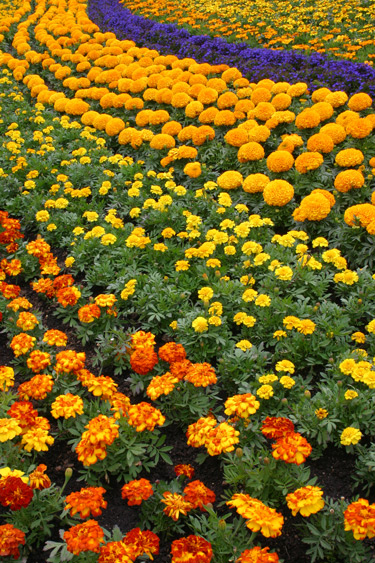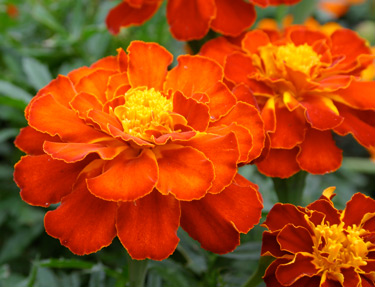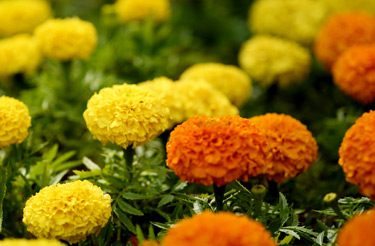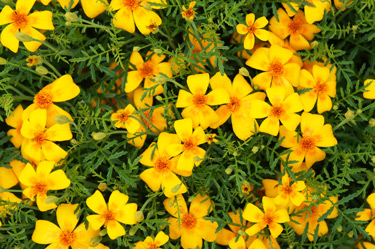Marigolds
Generous, cheerful resilient marigolds are hardy characters who get going when the going gets tough. That evocative scent like it or love it is also part of their charm as these are some of the best flowers for repelling insect pests, including mosquitos. Their orange and yellow tones look wonderful amid the lush greens of a summer salad garden. While other flowers struggle in the heat, marigolds box on, as fresh and youthful as spring.
Try yellow marigolds with cosmos, zinnias, Mexican sunflowers, geraniums or verbenas. And of course marigolds look fabulous with their fellow companion flowers such as borage, chives, and common sage.
Marigolds last well in a vase. In India, where the yellow colour represents happiness and life, marigolds are favourite wedding flowers.
Species and varieties
Marigolds (Tagetes) are often described as being African or French. Actually they’re mainly from tropical South America.
African marigold, Tagetes erecta, is a tall (45cm) plant with large flowers in colours ranging from lemon to dark orange.
Low growing Tagetes patula (aka ‘French’ marigold) is the forerunner to today’s exceptionally tidy and compact dwarf marigold varieties. Carnation-like doubles or daisy-like singles comprise many shades of yellow and orange.
Less well-known Tagetes species include Tagetes tenuifolia, the signet marigold, with delicate lacy, lemon scented foliage and Tagetes lemmoni a sprawling shrub up to 2m tall with lacy foliage. Perennial herb, Tagetes lucida (also known as Mexican mint and Texas tarragon) has a mild sweet liquorice taste said to be a good substitute for French tarragon. Tea made from this species is a popular drink in Latin America and has been used for centuries as a stimulant, digestive aid and hang-over remedy.
Success with marigolds
- Full sun and good drainage are essential.
- Plant seedlings from early summer, avoiding frost and cold soil.
- To grow marigolds from seed: Sow into seed-raising mix in spring or early summer (undercover if the weather is still cold). The light fine seed should be barely covered and usually germinates within 2 weeks. Prick out seedlings when they are large enough to handle, but delay planting out until the risk of frost has passed.
- Marigolds grow well in impoverished soil. A little slow release fertiliser will be beneficial for those grown in pots, but avoid nitrogen rich fertilisers.
- Water in dry weather but avoid excessive over-head watering.
- Remove dead blooms to encourage further flowering.
Marigolds as companion plants
Marigolds are among the most widely planted companion plants for the vegetable garden. In particular marigolds are said to be excellent guardians of tomatoes, lettuces, peppers, cucurbits, carrots and brassicas. By fending off the attackers or masking the more delicate smell of target plants, the distinctive marigold aroma is known to deter insect pests, especially white flies. Meanwhile the roots exude protective chemicals (allelochemicals) that can repel, and in some instances kill harmful soil nematodes.

5-Feb-2020

A mass planting of African and French marigolds

'French' marigolds

'African' marigolds

Signet marigold

